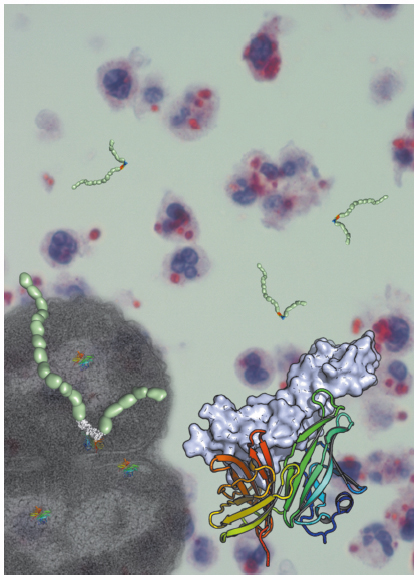- Home
- Users & Science
- Scientific Documentation
- ESRF Highlights
- ESRF Highlights 2009
- Structural biology
- Complex between Neisseria meningitidis factor H binding protein and two domains from human complement factor H
Complex between Neisseria meningitidis factor H binding protein and two domains from human complement factor H
Complement is an essential component of the innate and acquired immune system, and consists of a series of proteolytic cascades that are initiated by the presence of micro-organisms. In health, activation of complement is precisely controlled through membrane-bound and soluble plasma-regulatory proteins including factor H (fH), a 155 kDa protein composed of twenty domains (termed complement control protein repeats, or CCPs). Many pathogens have evolved the ability to avoid immune-killing by recruiting host complement regulators and several pathogens have adapted to avoid complement-mediated killing by sequestering fH to their surface. Using data collected at both the ESRF (ID29 and BM14) and Diamond (UK) we have solved the first crystal structure of a complement regulator in complex with its pathogen surface-protein ligand (Figure 110). This reveals how the important human pathogen Neisseria meningitidis subverts immune responses by mimicking the host, using protein instead of charged-carbohydrate chemistry to recruit the host complement regulator, factor H. The structure also indicates the molecular basis of the host-specificity of the interaction between factor H and the meningococcus, and informs attempts to develop novel therapeutics and vaccines.
 |
|
Fig. 110: The foreground shows a representation of two SCR domains from complement factor H (grey surface) in complex with the Neisserial factor H binding protein (cartoon, rainbow colouring). In the background an electron micrograph of Neisseria meninigitidis is overlaid on a field of N. meninigitidis infecting cells. |
Acknowledgements
This work was funded by grants from the Wellcome Trust and the Medical Research Council UK to SML and CMT. EK is an EMBO Fellow.
Principal publication and authors
M.C. Schneider (a,d), B.E. Prosser (b), J.J.E. Caesar (b), E. Kugelberg (a), S. Li (a), Q. Zhang (a), S. Quoraishi (b), J.E. Lovett (b), J.E. Deane (b), R.B. Sim (c), P. Roversi (b), S. Johnson (b), C.M. Tang (a), and S.M. Lea (b), Nature 458, 890-893 (2009).
(a) Centre for Molecular Microbiology and Infection, Imperial College, London (UK)
(b) Sir William Dunn School of Pathology, University of Oxford (UK)
(c) MRC Immunochemistry Unit, Department of Biochemistry, University of Oxford (UK)
(d) Present address: Harvard Medical School, Boston, Massachusetts (USA)



